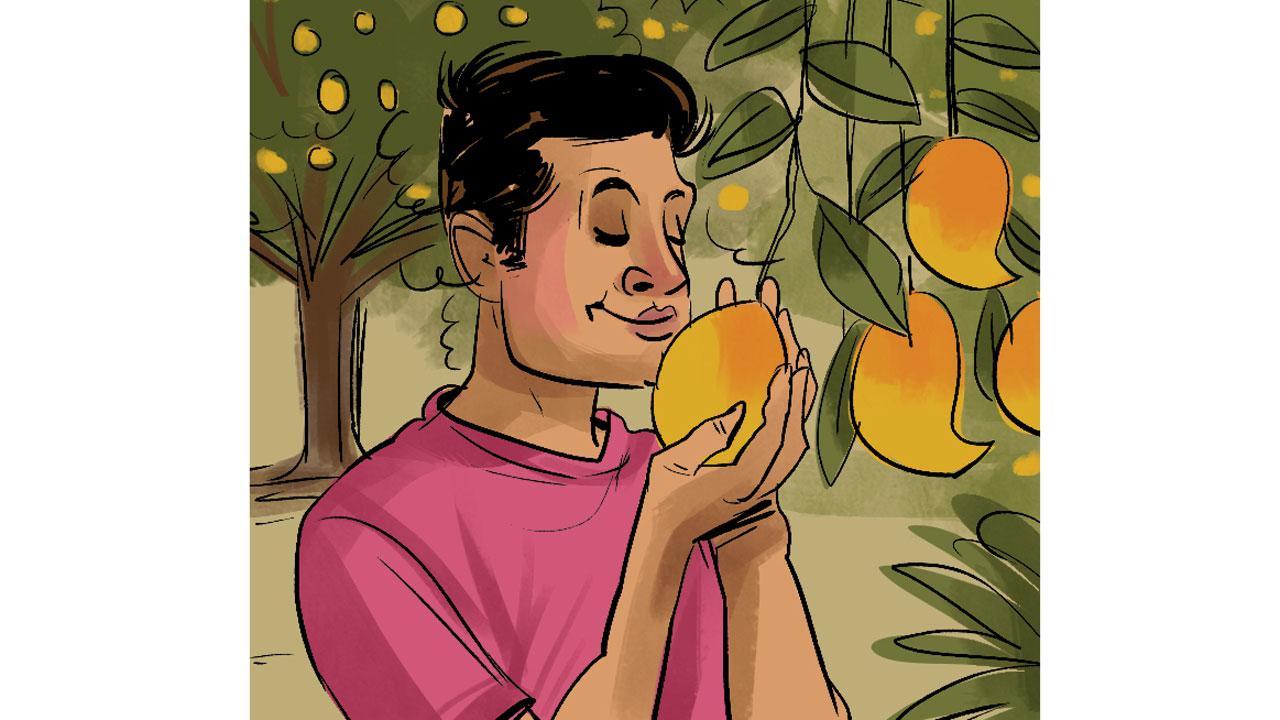It’s kind of the Bollywood of mangoes—high-profile, the elephant in the room, the assumption being that all other mangoes are chillarpatti

Illustration/Uday Mohite
![]() If there's one thing I find insufferable, it’s Alphonso mango snobs. Of course, Alphonso mangoes—daak naam hapus—are fabulous, no question. It’s kind of the Bollywood of mangoes—high-profile, the elephant in the room, the assumption being that all other mangoes are chillarpatti. But often, the Alphonso snobbery comes from a staggering ignorance of, and limited experience in actually eating, the rich variety of mangoes produced all over the country—1,500 Indian mango varieties, according to the National Horticulture Board. Let alone the extraordinary variety of mangoes grown in the Indian subcontinent, including Bangladesh, Pakistan, Sri Lanka, Nepal and even Bhutan. If people eat five mango varieties and grandiosely declare Alphonso the best, I’d suggest a mango poverty index, in this case five, on a scale of 0-1,500, based on how many mango varieties you have actually eaten. Alphonso is the King of mangoes—till you realise that almost every Indian state has its own king of mangoes. Anyway, its name comes from Afonso de Albuquerque (1453-1515), the Portuguese military expert who helped establish Portuguese rule in India; the Portuguese also introduced mango grafting to produce the Alphonso, so our Indian King comes from Portugal via Ratnagiri.
If there's one thing I find insufferable, it’s Alphonso mango snobs. Of course, Alphonso mangoes—daak naam hapus—are fabulous, no question. It’s kind of the Bollywood of mangoes—high-profile, the elephant in the room, the assumption being that all other mangoes are chillarpatti. But often, the Alphonso snobbery comes from a staggering ignorance of, and limited experience in actually eating, the rich variety of mangoes produced all over the country—1,500 Indian mango varieties, according to the National Horticulture Board. Let alone the extraordinary variety of mangoes grown in the Indian subcontinent, including Bangladesh, Pakistan, Sri Lanka, Nepal and even Bhutan. If people eat five mango varieties and grandiosely declare Alphonso the best, I’d suggest a mango poverty index, in this case five, on a scale of 0-1,500, based on how many mango varieties you have actually eaten. Alphonso is the King of mangoes—till you realise that almost every Indian state has its own king of mangoes. Anyway, its name comes from Afonso de Albuquerque (1453-1515), the Portuguese military expert who helped establish Portuguese rule in India; the Portuguese also introduced mango grafting to produce the Alphonso, so our Indian King comes from Portugal via Ratnagiri.
ADVERTISEMENT
Anyway, I’m anti-caste in life, and even more so when it comes to mangoes, and delighted to devour all kinds of mangoes—Dussehri, Kesar, Chausa, Langda, Totapuri, Pairi, and more. As soon as I returned from Cannes, I ordered organic mangoes from my favourite Sharan Organic Store—I’m a follower of Sharan India, an organisation that promotes holistic health, including through natural, organic, vegan and whole foods. They sent me Imam Pasand, Banganapalli, Ratna and Panchavarnam mangoes, the last two of which, I hadn’t even heard. The board survey of Mangifera indica includes Himsagar, Ambika, Malgova, Vanraj, Suvarnarekha, Malda, Badami, Sindhura, Kishen Bhog, Gulab Khas, Fazli, Fernandin, Mankurad and dozens more.
Imam Pasand (the Imam’s Delight) is a lovely, giant mango from Tamil Nadu, whose single fruit can weigh up to 1 kg. It seemed to have an after taste of earthy jasmine—I can’t explain it. And thanks to Sharan’s revolutionary Meet the Farmer online interview series, I learnt that organic farmer Hari Sethuraman from Chennai had been supplying the delicious Imam Pasands I’d been relishing; he and PB Murali have been running The Shandy, a popular organic store in Mylapore, Chennai, since 25 years. They have an orchard with 6,000 mango trees near Chennai. “You will realise that humans tend to go for sweetness, but birds have a better sense of flavour. So if you eat a mango that a bird has pecked, you will find it more flavoursome,” Sethuraman explained in the interview, and I was very drawn to how attuned he was to nature’s fine tastes. When they stopped using chemicals in the orchard, they were invaded by pests, and it meant significant initial losses, and years of “listening to nature,” to get it right. They allow a number of abandoned/hungry cows to graze freely, and let snakes potter about the property—and are blessed by having several bird visitors. Sethuraman seemed a very compassionate man, and I sensed a deeper connectedness with the earth, and all forms of life, with the mango being just one of many wonderful consequences.
Decades ago, when I lived in Paris, I bought mangoes—they came from Haiti—they looked voluptuous, blushing pink and enticing, but the taste revealed a miserable apology of a mango. And I believe mangoes in the US are called Kent and Tommy Atkins—whaaat? Nearer home, Bangladesh’s mango mania has reached dizzy heights: their national anthem Amar shonar Bangla, written by Rabindranath Tagore, even has the line, “O ma, phaagune tor aamer bone ghraane paagol kore” (Oh mother, the scent of your mango groves in spring drives me crazy). Bangladesh’s many mangoes include Fazlee, Gopalbhog, Mohanbhog and Lata Bombai. Pakistan’s mango varieties include Chaunsa, Anwar Ratol, Sindhri, Fajri and Lal Badshah. Sri Lankan mangoes include Karutha Colomban, Vellai Colomban, Willard, Ambalavi, Malwana, Peterpras and Dampara. Nepali mangoes include Bombay Yellow, Maldaha, Barbariya (I adore this chatterbox name), Chiniya, Mishrikand and Madhuwa. Even Bhutan’s mangoes include Bajo Aumchukuli and Samtenling Amchukuli. We urgently need more mango diplomacy and more aam dealers than arms dealers, especially in the Indian subcontinent. Every defence will collapse—if you seduce them all with mangoes.
Meenakshi Shedde is India and South Asia Delegate to the Berlin International Film Festival, National Award-winning critic, curator to festivals worldwide and journalist.
Reach her at meenakshi.shedde@mid-day.com
 Subscribe today by clicking the link and stay updated with the latest news!" Click here!
Subscribe today by clicking the link and stay updated with the latest news!" Click here!







